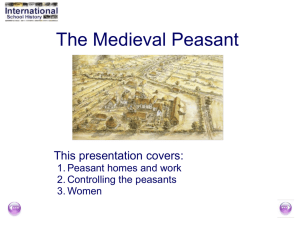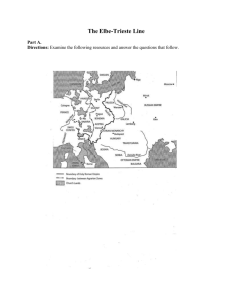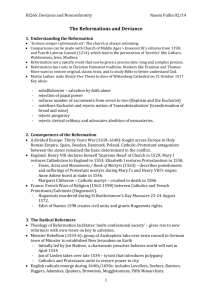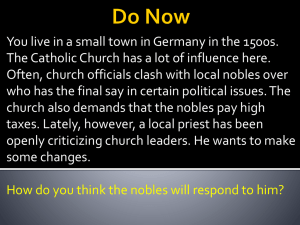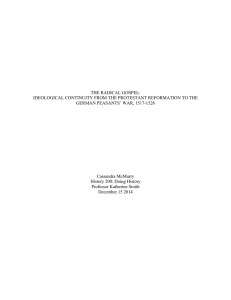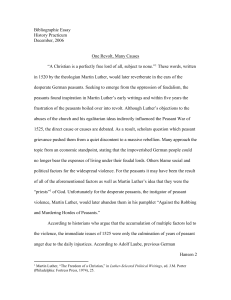Rural Reformation
advertisement
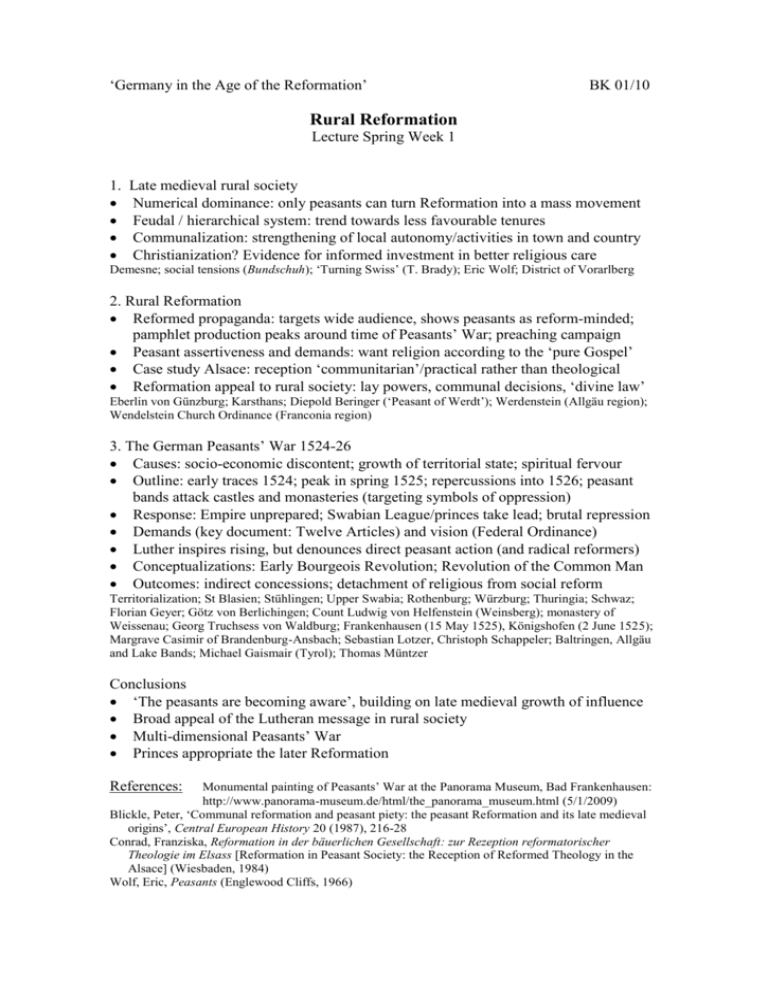
‘Germany in the Age of the Reformation’ BK 01/10 Rural Reformation Lecture Spring Week 1 1. Late medieval rural society Numerical dominance: only peasants can turn Reformation into a mass movement Feudal / hierarchical system: trend towards less favourable tenures Communalization: strengthening of local autonomy/activities in town and country Christianization? Evidence for informed investment in better religious care Demesne; social tensions (Bundschuh); ‘Turning Swiss’ (T. Brady); Eric Wolf; District of Vorarlberg 2. Rural Reformation Reformed propaganda: targets wide audience, shows peasants as reform-minded; pamphlet production peaks around time of Peasants’ War; preaching campaign Peasant assertiveness and demands: want religion according to the ‘pure Gospel’ Case study Alsace: reception ‘communitarian’/practical rather than theological Reformation appeal to rural society: lay powers, communal decisions, ‘divine law’ Eberlin von Günzburg; Karsthans; Diepold Beringer (‘Peasant of Werdt’); Werdenstein (Allgäu region); Wendelstein Church Ordinance (Franconia region) 3. The German Peasants’ War 1524-26 Causes: socio-economic discontent; growth of territorial state; spiritual fervour Outline: early traces 1524; peak in spring 1525; repercussions into 1526; peasant bands attack castles and monasteries (targeting symbols of oppression) Response: Empire unprepared; Swabian League/princes take lead; brutal repression Demands (key document: Twelve Articles) and vision (Federal Ordinance) Luther inspires rising, but denounces direct peasant action (and radical reformers) Conceptualizations: Early Bourgeois Revolution; Revolution of the Common Man Outcomes: indirect concessions; detachment of religious from social reform Territorialization; St Blasien; Stühlingen; Upper Swabia; Rothenburg; Würzburg; Thuringia; Schwaz; Florian Geyer; Götz von Berlichingen; Count Ludwig von Helfenstein (Weinsberg); monastery of Weissenau; Georg Truchsess von Waldburg; Frankenhausen (15 May 1525), Königshofen (2 June 1525); Margrave Casimir of Brandenburg-Ansbach; Sebastian Lotzer, Christoph Schappeler; Baltringen, Allgäu and Lake Bands; Michael Gaismair (Tyrol); Thomas Müntzer Conclusions ‘The peasants are becoming aware’, building on late medieval growth of influence Broad appeal of the Lutheran message in rural society Multi-dimensional Peasants’ War Princes appropriate the later Reformation Monumental painting of Peasants’ War at the Panorama Museum, Bad Frankenhausen: http://www.panorama-museum.de/html/the_panorama_museum.html (5/1/2009) Blickle, Peter, ‘Communal reformation and peasant piety: the peasant Reformation and its late medieval origins’, Central European History 20 (1987), 216-28 Conrad, Franziska, Reformation in der bäuerlichen Gesellschaft: zur Rezeption reformatorischer Theologie im Elsass [Reformation in Peasant Society: the Reception of Reformed Theology in the Alsace] (Wiesbaden, 1984) Wolf, Eric, Peasants (Englewood Cliffs, 1966) References: [Map of Peasant War from Dixon, Reformation, 82]
